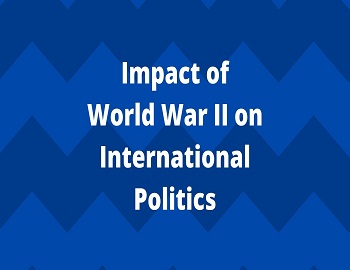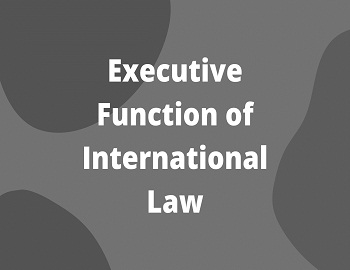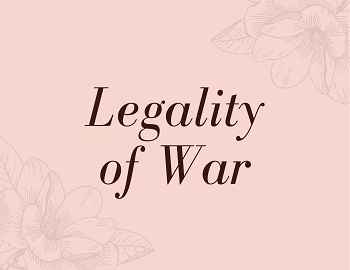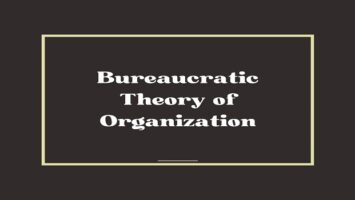Table of Contents
Impact of World War II on International Politics:
The greatest and the most destructive war in history- World War II- lasted for six years and ended in Europe with the unconditional surrender of Germany on May 7th, 1945, and in Asia with that of Japan on August 14th 1945. The casualties in the war were approximately two and a half crores dead and three and a half crores wounded. The bombarding of Hiroshima and Nagasaki proved that nuclear war has begun and it can destroy human civilization at any moment.
After World War II the situation on an international level changed entirely. The balance of power was shifted. Europe did not remain the centre of international politics. America and Russia came up as the two great powers and France and England receded into the background. Apart from these two blocks, the non-aligned groups came into being. In fact, World War II has a great impact on international politics.
The points of the impact of World War II can be broken down as under-
- Emergence of Two Power Blocs- New Balance of Power.
- Uncommitted Nations.
- Cold War.
- Non-alignment.
- Birth of U.N.O.
- Growing Concern for Peace.
- Experiments in European Integration.
- Spread of Socialism.
- Spread of the Ideal of World Government.
Emergence of Two Power Blocs- New Balance of Power:
After the Second World War, the balance of power in the world underwent a vital change. Two superpowers, the U.S.A. and the U.S.S.R. emerged. The other states in the world went either with the one or the other of the two super-powers of blocs; this development has resulted either in the ideological leaning of the states concerned or it has proceeded from circumstances, such as geography, strategic needs of the two blocs which have constrained them to so line up. This development is called polarization and bipolarization.
After Second World War the balance of power came to be polarized between two superpowers- the U.S.A. and the Soviet Union, for only these two nations emerged as strong enough after the World War whereas other powers Germany, Italy and Japan were defeated and others Britain and France though victorious, emerged broken. The bipolarization of the balance of power created two blocs in world politics, the communist bloc led by the USSR and supported by the allies like Poland, Hungary, East Germany, Bulgaria, Czechoslovakia, Rumania, outer Mongolia and so on; and the democratic bloc led by the U.S.A. and supported by the allies like Britain, France, West Germany, Italy, Japan, New Zealand, Australia etc. The first group is bound to the USSR by various treaties and pacts like the Warsaw Pact, and economic associations like COMECOW while the second group of nations is bound to the USA through various alliances such as NATO, SEATO, CENTO and ANZOS etc.
Another factor that gave rise to the bipolarization of world politics is that both the superpowers possessed a large stock of various nuclear and long-range delivery vehicles. This can have a decisive influence on the war. Lesser powers like the U.K. and France, though they possess nuclear weapons, cannot have a decisive influence on the war. As such the bipolarization of the balance of power between the U.S.A. and the U.S.S.R. and supported by two blocs system of nations continues to exist.
The Uncommitted Nations:
After Second World War there came the uncommitted nations. Such nations include Arab countries, India, Ceylon, Burma, Indonesia, Yugoslavia etc. These uncommitted nations keep an open mind on all international issues. As Prof. Morgenthau remarks, “the development of the world balance of power in the immediate future will largely depend upon the course these uncommitted nations will take”. In fact, these nations have a large population and are struggling hard to develop their political, economic and industrial power. They are now increasingly making their influence felt, particularly in the U.N.O. These nations are playing a significant role in the relaxation of tension, pacific settlement of international disputes and disarmament programmes particularly the ban on nuclear weapons. The nations have plainly refused to join either bloc. This may be said to have given rise to six main forms of attitudes and opinions-
(1) The struggle between the two sides was viewed by these states as being essentially one of the moves on a chessboard rather than a struggle between two systems of a social organization dedicated primarily to moral and ideological considerations.
(2) The memory of colonial rule ensured that these states supported international action against policies like racial discrimination which were the legacy of an imperialist era and sought initiatives to deny political roles to states which did not pursue the policy of anti-colonialism with vigour and fortitude.
(3) These states sought to extend the scope of activity by the United Nations. They helped to evolve new ideas by which international institutions were revived to help maintain world peace and to promote economic and technical assistance and scientific and cultural cooperation.
(4) The new members of the international community urged the importance and utility of the new method of negotiation in settling international issues.
(5) Many of the new states sought to avoid military alliances and especially the setting up of permanent military bases which they believed did not enhance but reduced general security.
(6) They welcomed economic and cultural cooperation with both the United States and the Soviet Union. An important assumption they made was that neither of these powers had the objective of world conquest. Although the United States and the Soviet Union in their polemical exchanges accused each other of being Hitler’s heir, the new Afro-Asian states believed that even at their worst both of these powers were fundamentally different from the model of Nazi Germany.
Cold War:
Cold War is an aftereffect of the Second World War. But Cold War is not a new feature. It existed even before World War II. But it is only after World War II that it assumed wider dimensions.
After the Second World War, the whole world was engaged in the cold war. The origin of the cold war can be divided into the following phases-
(I) From 1946 to 1953.
(II) From 1953 to 1958.
(III) From 1958 to the present.
First Phase From 1946 to 1953- This is the first phase of the cold war. During this phase, America resorted to direct military intervention through the Truman Doctrine of March 1947 and economic integration of West European powers by the Marshall Plan of June 1947.
The following lines throw ample light on this phase of the cold war:
The Berlin blockade, from early 1948 until May 1949, was the first open test in the Cold War. It was a struggle fought with weapons of blockade and air-lift and not only this test but hardened American resolution to carry containment through to completion; it also helped to bring the birth of the North Atlantic Treaty Organization in April 1949.
This phase of the cold war ended with the establishment of NATO on April 4, 1949. The North Atlantic Treaty was signed in Washington on April 4th, 1949, by the United States, Canada, Belgium, Denmark, France, Iceland, Italy, Luxembourg, the Netherlands, Norway, Portugal and the United Kingdom. Greece and Turkey became members in February 1952. The Federal Republic of Germany joined NATO in May 1955.
Second Phase From 1953 to 1958- During this period, the U.S.A. continued to give economic and military assistance against U.S.S.R. The death of Stalin in 1953, brought some change in the cold war. There was a temporary recess in the cold war. But soon after the Russian leaders were not satisfied with the attitude of western powers. As such, the cold war continued during this period.
During this period important treaties such as SEATO and WARSAW Treaty were concluded.
Third Phase From 1958 to the Present- This phase started in 1958. It saw the Cuban Crisis, Vietnam Crisis etc. During this period, Partial Test-Ban Treaty, Non-Proliferation Treaty came to light. The West Asia Crisis of 1973 still causes a good deal of war. As a London Newspaper observes: The present conflict by far the most formidable in the equipment of both sides, is putting the two super-powers into straining situations. It is unthinkable that the United States should allow Israel to be crushed (if that possibility were to arise) and therefore certain that the Americans would have to pour in planes and guns if Israel urgently needed them. But there is no sign that Washington welcomes having to play this role.
Similarly, it would be almost equally difficult for the Soviet Union to stand by and do nothing if the armies of the Arab states, which the Russians have equipped, were to be smashed for the fourth time. The Russians would find it particularly difficult to abandon the Arab states together because of a major political fact; the Arab cause of regaining their occupied territories is a popular cause with most of the states of the world. This same fact makes it impossible for the Chinese to declare themselves neutral.
The Americans, with their barely achieved link with the Russians and Chinese for the explicit purpose of working together to keep the peace, are finding this new link inoperative in these circumstances. Whatever may be going on privately between Washington and Moscow to keep the war from spreading, the fact of this war, fought with super-power equipment, with all the world watching to see which shall let down his client, is bound to exacerbate their relationship.
The kind of misunderstanding that can arise is seen in the allegations coming from Washington that the Soviets are deliberately inciting Algeria, Iraq and other Arab countries to go to the help of the Egyptians. This must look like a deliberate attempt by the Russians to widen the war. But these actions may, in fact, be due to a Soviet wish to avoid getting drawn into the war themselves. It can easily be seen how much misapprehension could seriously injure the fragile confidence between the superpowers that both of them want, above all else, peace.
In fact, the cold war today is guided by ideological factors and also by the desire for superiority by the great powers. This is made clear by the committee on foreign affairs of the U.S.A.’s House of Representatives.
Non-Alignment:
Non-alignment states include all those that reject alignment with either the Communist camp or the Anti-Communist Coalition. Non-alignment is one of those phenomena which appeared on the International scene after World War II when there was a disintegration of European colonial empires. Most of these states which became independent after the decline of the European colonial empires adopted the policy of non-alignment. In fact, all these countries after attaining independence refused to join the existing military alliances, although their economic weakness, their military weakness and the former allegiance would have indicated the opposite course. These nations wanted to take an active part in the shaping of their own future and accordingly influence world affairs in general. All these nations felt that the only way through which they could achieve their goal was to adopt a policy of non-alignment. As Marko Nikezic writes, “This seems (to us) to be….the only way in which (the new nations)…..can secure for themselves their fast development, and there is a proof of it, because, today, nationalists of all shades are discovering that road”. Pt. Nehru said in 1946 that India should “keep away from the power politics of groups aligned against one another, which has led in the past to two world wars and which may again lead to disasters on an even vaster scale”.
Birth of UNO:
The United Nations was born in the tragedy of World War II. Its primary purpose is the maintenance of peace. Its Charter begins by stating that the peoples of the world are combining their efforts to accomplish certain objectives. The first objective was “to save a succeeding generation from the scourge of war, which twice in our lifetime has brought untold sorrow to mankind……….”
In the next objective, the charter declared: “to reaffirm faith in fundamental human rights, in the dignity and worth of the human person, in the equal rights of men and women and of nations large and small…….”
In the third objective, the framers of the Charter addressed themselves to the political and legal side and determined “to establish conditions under which justice and respect for the obligations arising from treaties and other sources of International Law can be maintained”.
United Nations has vast responsibilities for the maintenance of peace and security. According to Article I of the Charter, it is expected to take effective collective measures for the prevention and removal of threats to peace, and for the suppression of acts of aggression or other breaches of the peace, and to bring about by lawful means, and in conformity with the principles of justice and international law, adjustment or settlement of international disputes or situations which might lead to a breach of peace.
The United Nations has done much valuable and spectacular work in maintaining international peace and security. It has prevented, stopped or moderated wars in Indonesia, Palestine, Kashmir, Korea, Iran, Suez, Congo and Cyprus. Speaking on the first ten years’ role of the U.N., Kenneth Yonger observes, “During the first ten years of its existence, the United Nations has become pretty firmly established in the minds of the people throughout the world, first as a symbol of the hope that a major war in the future can be avoided and secondly, as an important forum for international discussion and, to a lesser extent, of negotiation. The United Nations survived the various crises in the relationship of the Great Powers between 1947 and 1954 and it seems unlikely that anything short of the outbreak of a major war would now threaten its existence”. According to Former President Carlos P. Romulo, “There are cogent reasons for keeping up the United Nation’s strength. It is a vast organization where the two sides in world affairs maintain daily diplomatic and political contact which itself is a force for peace. It provides the last chance to keep the transition from colonialism to self-rule- one of the world’s critical problems- peaceful and sane instead of bloody. Kill the United Nations and you blow up the dam that has already prevented four local wars from spreading- Korea, Indonesia, Kashmir, Palestine- and could do the same in future. Kill the United Nations and you increase tremendously the chances that man will one day wipe himself off the face of the earth”. According to another writer, “The United Nations is not only an institution for exchanging opinions but also one for maintaining peace. In practice, however, the United Nations has chiefly played the role of a forum for the international exchange of opinions.
Growing Concern For Peace:
The havoc caused by the Second World War has shown how the scale of physical destruction, as well as the scope of modern warfare, has steadily expanded. Research in modern warfare has made such great progress that Dr Gerald Wendt asserts, “If World War III comes, which we pray will never happen, it will be a war in which most people may die from silent, insidious, anti-human weapons that make no sound, give no warning, destroy no forts or ships or cities, but can wipe out human beings by the millions”.
According to Schleicher, “Men best acquainted with the facts are most likely to believe that something must be done if civilization is not to be destroyed in a nuclear holocaust”. For so many centuries the peace-seekers of the world have believed that wars are caused by armaments and that peace can be had by reducing or limiting certain or all types of armaments. As such, the best solution lies in disarmament, which is called by Sprout and Sprout, “an ideal solution in all other respects”.
As such, there was great concern for peace after the Second World War.
Experiments in European Integration:
After World War II the necessity of world integration was felt in every corner of the world. As such experiments in integration were made in Asia, Europe and other places. Various treaties and pacts were concluded for integration. About integration in Europe Sir Winston Churchill wrote on March 5, 1946.
“The safety of the world requires a new unity in Europe from which no nation should be permanently outcast. It is from the quarrels of the strong parent races that the world wars we witnessed or which occurred in former times have sprung…….Surely we should work with a conscious purpose for a grand unification of Europe within the structure of the United Nations”. In another speech on September 19, 1946, Sir Winston Churchill declared, “The sovereign remedy of Europe is to create the European family, or as much of it as we can, and provide it with a structure under which it can dwell in peace, in safety and in freedom. We must build a kind of United States of Europe”.
Numerous pacts and treatises were concluded as a trend toward integration in the world. As such the British Commonwealth of Nations, NATO, SEATO, CENTO or BAGHDAD Pact, EEC etc. are some of the interesting experiments towards the integration of the world.
Spread of Socialism:
Another impact of the Second World War was the spread of socialism throughout the world. In the process of reconstruction works, the underdeveloped world particularly Asia and Africa took serious steps to formulate economic plans based on the socialistic patterns.
Spread of the Ideal of World Government:
Another effect of World War II was the spread of the ideal of world federation.
Since World War II the United Federalists have been the most prominent advocates of world government in the United States. Their plan is universalist, and once their world federation is organized, they would deny a right to secession. At least in the early phases of its operation, its plan is also minimalist. They start with the UN Charter, seeking action under it and amendments to it, emphasizing universal and complete disarmament, judicial settlement, and “an adequate armed peace force”. They would eliminate the veto in the Security Council, and make it “responsible” to the General Assembly. In the latter body, they would abandon the one-member-one-vote formula and adopt a formula that is “more just and realistic”. Understandably, the many elements of the programmes are left vague. Overlapping the movement for world federation is a movement for “peace through law”.
In fact, now, as Prof. E. Asirvatham says, that scientific discovery of recent years, greater facilities of travel and greater intercourse among the people of the world, international trade on a gigantic scale and the world magnitude of present-day problems, all of which are causing “the shrinkage of the world” tend to break down narrow ideas of Patriotism and national sovereignty and point the way to some form of world federation.
H. J. Laski, an ardent champion of the World Federation, believes that in other than purely domestic concerns settlement in terms of common rules for all nations is becoming an increasing necessity. He holds that the sovereignty of the state is in the process of disappearance international affairs because it has served its purpose there. “What the individual today requires is not the concept of Imperialism, but the concept of Federalism”.
In his book ‘Union Now’ Clarence A. Streit visualizes a federal union of the existing democracies. He argues that the League of Nations failed because it was a league of governments and not of peoples. Holding that the doctrine of absolute sovereignty is altogether unsuited to modern conditions, he argues for a world government of the federal type.
The broad outlines of the scheme have received the approval of Lionel Curtis and a group of people in England who have organized themselves into a union to explore practical ways of giving effect to the scheme.
Alfred Tennyson, an English poet of the nineteenth century, has envisioned a “parliament of man and federation of the world”. H. G. Wells, another Englishman of our day, also thought and wrote on world terms.
After the Second World War, there is a great keenness for world unity. All eyes are set on the U.N.O for bringing about a world government.
To those who are eager to bring about a world federation overnight, the following words of A. J. Toynbee have a direct relevance “The United Nations Organization may fairly be described as a political machine for putting into effect the maximum possible amount of cooperation between the United States and the Soviet Union- the two great powers who would be the principal antagonists in a final round of naked power politics. The present constitution of the U.N. represents the closer degree of cooperation that the United States and the Soviet Union can reach at present”.
Reinhold Neibuhr, a well-known American thinker, says that the world community is essential to world government. He rightly contends that a world community cannot be made to order by legal, constitutional and governmental means. In his own words “The community cannot be coerced into basic order; the basic order must come from its innate cohesion”. There is yet no “we” feeling in the world.
Conclusion- To conclude we can say that the effects of World War II were numerous. The emergence of bipolarity, the cold war, non-aligned nations, new values, U.N.O. are the major developments after World War II.









Comments (No)